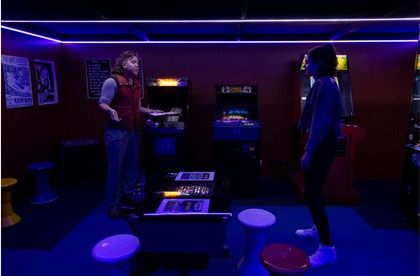Theatre maker David Harris on finding your feet with Immersive Theatre
Deep water is scary. You can’t see the bottom most of the time, and the unknown can fill your head with images of grey objects with white teeth. To dive in is an act of submission.
Your senses come alive. The water covers your face, wriggles into your ears, pushes under your eyes, coating your skin. Even the sound of the water itself takes on a quality of gentle transition. There is no escaping the experience of water. With no solid ground beneath your feet you may panic, worried that the fullness of the moment may overwhelm you, and the momentum of the water might sweep you away entirely. Once you calm your senses, find your balance and begin to swim, you perhaps realise the water might not be such a terrifying place, but another world to explore.
It’s a bit like immersive theatre.
In immersive theatre, audience comes first. As immersive theatre-makers we must recognise that we are creating worlds for our divers to navigate however they see fit.
I’ve been making immersive theatre for the last decade, a small time in the large scale of the medium. But I am deeply passionate about the style and its possibilities. I started a PhD on how the immersive experience places audience agency. In my practice I’ve directed, written, and performed in shows such as I AM GOOD, These Muddy Waters and Teatro de los Sentidos’ Echo of the Shadow. Recently I sat in on Because The Night rehearsals and watched the navigation of immersive Shakespeare. I’m always fascinated how each of these works have changed dramatically with the audience guidance. How the distance between the work and audience dissipated, and audience became artist. How they entered the water.
I have also asked to advise on other works as well. One work I was helping required audiences to get on stage and plead their case on an ethical issue. The artist was so worried that the story they wanted to tell would be jeopardised by the audience saying the wrong thing. They asked if there was any way to insure against such a possibility, to make sure the heavily structured narrative would be left in perfect condition. My answer was a simple no.
Well, mostly no. You have to give up that control a little, change your mindset from storyteller to story curator. The audience steps up and takes centre stage.
Our audiences are the number one concern when thinking about the immersive space. Their safety, their placement, and their role is the focal point. The whole piece must revolve around their experience.
If, as immersive theatre-makers, we want to give the audience freedom then the narrative must come second.
Concepts that rely on overly rigid scripting or story will struggle to be flexible enough to nurture the audience’s agency. You can have a story, just be prepared for it to be disjointed, disorientating, and sometimes completely scrambled when the audience’s decisions challenge your expectations. And that is so beautiful, because they’ll show you things you never saw in the first place.
For this reason, I approach theatre-making as a constructed set of experiences, and engage the audience in the process of assembly. A diver doesn’t enter the water for a simple story—they don’t delve down into the abyss or chase fish across shoals to hear a nice three act structure. Making a world for audiences to explore is much more interesting.
But how do we make sure that the experience is what we intend? Surely writing a script is easier, having the work structured is better, right?
Going back to the diver, we can still shape their engagement with the world without prescribing a rigid story. Middle of the Pacific? Deep dark water but no schools of fish, no corals, just the big blue—an environment that might make the diver feel small, reflective, alone. If we take them to a coral reef, their experience will be vastly different: lots of light, colour, fish to play with. They can gorge on the frenzy of spectacle. They might not have scripts, but they are still curated. The guidance of you the creator, and the will of the audience is a careful balance. Fish might be curious about the diver, and the diver might move around to a piece of coral yet unseen. The artist creates an impactful world for the audience, but the story and script is of the audience’s making.
As artists making immersive theatre, the biggest challenge can be letting go of control.
If you want to plan for everything, then just throw it on a traditional stage—most likely it’ll work better. But down here, audiences are our divers, and we can’t force them to swim in certain ways, float in awkward directions, turn their heads to watch certain fish. We are the coral growers, the fish breeders. We can cultivate currents in the water. Do our audiences swim through kelp forests? Or explore watery shipwrecks? To create good immersive theatre, we must break away from traditional storytelling practices, from the tyranny of watertight logic, and neat endings. To be immersed is to be submerged, and in that submersion, you must give up control, and let the audience show you the story.
When the divers surface they’ll greet each other. They’ll strip their wetsuits and head to the bar, they’ll talk about all the strange things they saw. Not one of them will have the same experience, have seen the same things—and they’ll love it.
David Harris is a theatre-maker and game designer, and a PhD candidate from Victorian College of the Arts, examining the function of agency, interactivity, and audience in immersive and interactive theatre. He currently lectures and teaches Game Design at Swinburne University of Technology.
You can read more about his work at www.dgharris.info

